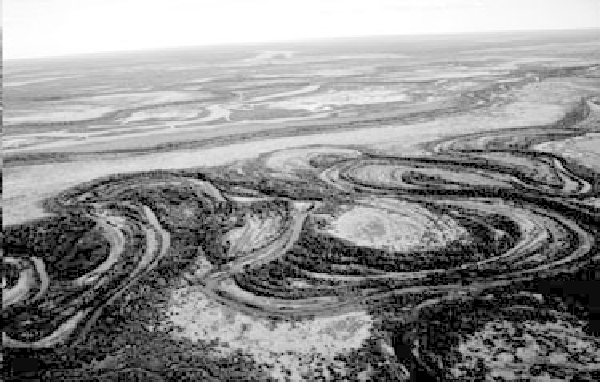Geoscience Reference
In-Depth Information
neither erosion nor deposition, is to be maintained. If slope
stayed constant or increased, then erosion would result in a
lowering of the bed and the production of a concavity.
Profile concavity may be described by an equation of the
form
H
may be studied from aerial photographs since slow
migration of bar and/or channel leads to partial preservation
of the barform as topographic features (
swale-and-ridge
topography) in plan view. These are the surface expressions
of periodic
lateral accretion
of sediment on to the bar,
particularly due to flow expansion downstream.
Helical flow due to radial forcing (Section 3.7) is the
common denominator to each kind of sinuous channel
reach. It causes downstream bar migration to be accompa-
nied by bar lateral accretion. Why is this? Owing to helical
flow, the bed shear stress vector deviates by a small angle
H
0
e
kL
, where
H
is local profile height with
respect to an initial height
H
0
,
k
is an erosional or
depositional constant, and
L
is distance downstream. The
downstream concavity of profile in most aggrading
rivers (ignoring the effects of tributaries) leads to a diminu-
tion of bed shear stress and hence to a general downstream
fining of bed sediment grain size, although abrasion due to
transport also undoubtedly contributes to this.
Channels possess form as well as magnitude and are best
described by a combination of:
Planform deviation from a straight path (
sinuosity, P
)
Degree of channel subdivision by mobile bars (
braiding
)
Degree of channel subdivision by permanent islands
(
anastomosing
)
No rigid classification of any single channel on anything
longer than a reach level (a few channel widths) is univer-
sally practicable since many rivers show combinations of
sinuosity and braiding.
Concerning river channel sediment transport processes,
the largest river bedforms have dimensions that bear some
constant relationship with the dimensions of the contain-
ing channel. The bedforms, henceforth referred to as
bars
,
are said to scale with the channel size, usually expressed as
total active channel width, and are frequently referred to as
macroforms
. These include point, lateral, and in-channel
bars (Figs 6.64-6.66). The former positions of barforms
from the mean flow direction, so that near-bed sediment
grains tend to move inward (Fig. 6.65). From theory and
experiment tan
11
h/r
, where
h
is local flow depth and
r
is the local radius of curvature of the bend. The actual
path of a moving bedload grain depends upon the balance
of the frictional, fluid, and gravity forces acting on it. For
steady, uniform flow the net rate of transverse sediment
transport must be zero, or a stationary bed cannot be
attained. To counterbalance the inward transport, a trans-
verse bed slope develops. This is the point bar or channel
bar lateral surface where grains travel parallel to the mean
flow direction, around the “contours” of equal bed shear
stress. Given a wide range of available grain sizes,
will
vary directly with bed shear over any bar surface, the gen-
eral decline of shear as the water shallows causing a general
lateral fining from bar toe to top. At the same time as this
inner bend deposition, erosion of the outside bend
cut-bank
takes place. The rate of this depends upon the structure of
the bank and the properties of its constituents - whether
SRT
Fig. 6.64
Meander bends of a sinuous reach (
P
2), South Angling Channel, Saskatchewan River, Canada. The light grey areas on the inside
bends are exposed parts of sandy point bars revealed at low river flow. These extend below water into the deepest part of the channel. The dark
wooded areas inboard of each point bar are older active bar surfaces recording the gradual outward migration of the channel bends with time.
Faint concentric lines are
swale-and-ridge topography (
SRT
)
; this marks former inner banks to old active point bar surface margins.


Search WWH ::

Custom Search